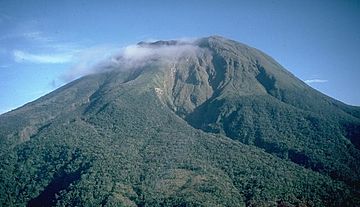Mount Bulusan facts for kids
Quick facts for kids Bulusan Volcano |
|
|---|---|
| Mount Bulusan | |

Bulusan volcano seen here from the west
|
|
| Highest point | |
| Elevation | 1,565 m (5,135 ft) |
| Prominence | 1,547 m (5,075 ft) • |
| Geography | |
| Country | Philippines |
| Region | Bicol Region |
| Province | Sorsogon |
| City/municipality |
|
| Geology | |
| Last eruption | December 2016 |
Mount Bulusan is an active volcano located in the Sorsogon province, within the Bicol Region of the Philippines. It stands on the southern part of Luzon Island. This volcano is known for its frequent, but usually small, eruptions.
Contents
What is Bulusan Volcano?
Mount Bulusan is a type of volcano called a stratovolcano. This means it's shaped like a cone and built up by many layers of hardened lava, ash, and rocks. It is the highest point in Sorsogon province.
Location and Surroundings
Bulusan Volcano is part of the Bicol Volcanic Arc. This is a chain of volcanoes found along the eastern side of the Bicol Region. The volcano is surrounded by four towns: Bulusan, Irosin, Juban, and Casiguran.
Bulusan Volcano Natural Park
The volcano and its nearby areas are protected as the Bulusan Volcano Natural Park. This park covers about 3,672 hectares (9,074 acres). It's a home for many different plants and animals. The park also includes the beautiful Bulusan Lake, which is a popular spot for visitors.
Volcanic Activity
Mount Bulusan is one of the most active volcanoes in the Philippines. It has erupted many times throughout history. Most of its eruptions are phreatic, which means they are caused by steam. This happens when hot magma heats up groundwater, turning it into steam that then explodes.
Recent Eruptions
Bulusan Volcano has had several eruptions in recent years.
- In 2006, it had a series of ash explosions. These sent ash plumes high into the sky.
- More activity occurred in 2010 and 2011, with small ash eruptions.
- In 2015, the volcano showed more signs of unrest, leading to ash falls in nearby towns.
- The last recorded eruption was in December 2016. This was also a phreatic explosion.
Alert Levels
When Bulusan Volcano shows signs of activity, scientists use an alert level system.
- Alert Level 0 means no unusual activity.
- Alert Level 1 means there is some low-level unrest. This might include more earthquakes or steam coming out.
- Higher alert levels mean more serious activity, like bigger explosions or lava flows. People living near the volcano are often advised to stay away from a danger zone, usually within 4 kilometers (2.5 miles) of the crater.
Why is Bulusan Active?
Bulusan Volcano is active because of where it is located. The Philippines sits on the Pacific Ring of Fire. This is an area around the Pacific Ocean where many earthquakes and volcanic eruptions happen. It's where several of Earth's large tectonic plates meet and move against each other. This movement causes magma to rise to the surface, forming volcanoes.
Images for kids
See also
 In Spanish: Monte Bulusán para niños
In Spanish: Monte Bulusán para niños


